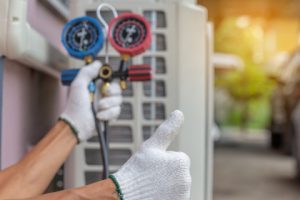Get the most cooling for your dollar this summer
University of Illinois Extension Services — July 16, 2020
Energy experts encourage homeowners to conduct an energy audit to see if they can save on home cooling costs. (Photo courtesy of University of Illinois Extension)
As the temperatures soar, there are simple ways to save money on energy bills this summer.
According to the Department of Energy, a typical home uses 48 percent of energy expenditures just on the heating, ventilation, and air conditioning system. “Although a lion’s share of that percentage goes to heating homes, Americans still spend $29 billion every year to power their air conditioners,” says Erin Hollinshead, executive director of Safe Electricity.
Aside from replacing central air conditioners with a newer, higher-efficiency model, there are some things one can do to increase efficiency during the hottest part of the year, which can help reduce energy bills.
Hot temperatures are hard on people, pocketbooks, and electrical systems. Increased demand for electricity during the summer strains a home’s electrical system, increasing the likelihood of an electric shock or fire. This high demand for electricity also makes it more expensive in summer months.
“Cooling your home efficiently this summer does not have to be difficult,” says Hollinshead. “Major projects will boost your home’s efficiency, but simple behaviors are also important in increasing efficiency and are not to be overlooked. By preparing your home, you can save money, stay comfortable, and decrease demands on the electrical system.”
Safe Electricity provides the following tips to save money on cooling costs:
- Close curtains, blinds, and shades during the hottest part of the day. Not only is about one-third of a home’s energy lost around windows, but about 76% of sunlight that falls on standard double-pane windows enters the home to become heat, according to energy.gov.
- If you don’t already have one, install a programmable or smart thermostat. One can save up to 10 percent a year on heating and cooling by adjusting the thermostat seven to 10 degrees from its normal setting for eight hours a day, Hollinshead says.
- Clean the air filter and get the unit inspected by an HVAC professional.
- Keep the outdoor condenser unit clean and free from debris. Ideally, the unit should be in the shade.
- Consider changes to your landscaping. Greenery that includes shade trees and those that insulate the foundation can reduce energy costs.
- Ventilate the attic and check insulation. Adequately sized vents and an attic fan can help remove hot air from buildings. If your attic has less than 6 to 8 inches of insulation, consider adding more. By addressing air leaks around your home and adding insulation, homeowners can save around 10 percent annually on energy bills (energystar.gov).
- Use clothes dryers and ovens during the cooler parts of the day.
- Consider a professional energy audit to reveal where the home is inefficient, including air leaks and exposed ductwork.
- Use ceiling fans that circulate air and take heat from the body’s surface to create a cooling effect.
- Keep cool air in and hot air out. Avoid unnecessary trips out the door, and do not leave the door open.
- Shade your home by installing awnings over windows in direct sunlight.
- Make sure your home has the insulation it needs. Energy.gov has information about the best insulation to use in different geographic areas.
- If you are building a new home or replacing your air conditioner, there are options to maximize efficiency. For starters, look for the Energy Star label for air conditioners that have met energy efficiency guidelines set by the U.S. Environmental Protection Agency.
Increased summer electric demand not only affects the monthly budget, but it can also seriously strain your home’s electrical system, which may create dangerous shock and fire hazards.
Flickering or dimming lights or frequent circuit breaker trips are signs of an overloaded electrical system or faulty wiring that should be checked immediately by a qualified electrician, Hollinshead says.
SOURCE: Erin Hollinshead, executive director, Safe Electricity







